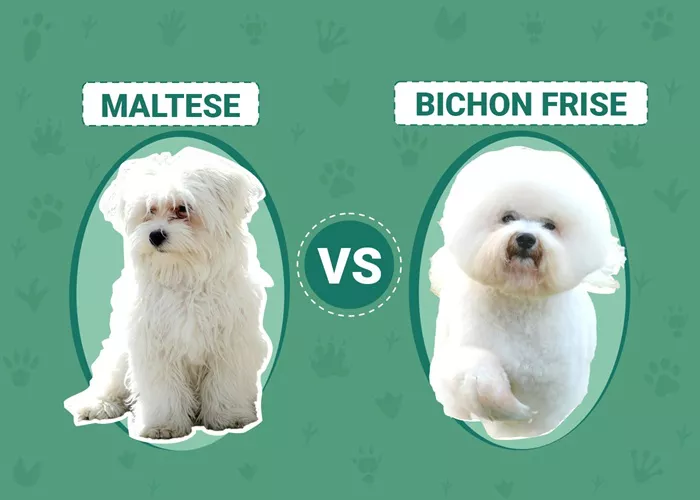Choosing between a Maltese and a Bichon Frise can be challenging, as both breeds are beloved for their affectionate personalities, hypoallergenic coats, and adaptability to various lifestyles. While they share similarities, such as Mediterranean origins and roles as companion dogs, they differ in grooming needs, temperament, and health considerations. This article compares these two popular small breeds to help potential owners make an informed decision.
Breed Overview
Maltese
The Maltese is a toy-sized breed originating from Malta, known for its silky white coat and expressive dark eyes. Historically favored by royalty, this breed weighs 4–7 pounds (1.8–3.2 kg) and stands 8–10 inches (20–25 cm) tall. Maltese dogs are affectionate, alert, and thrive on human companionship. Their long, flowing coat requires daily brushing to prevent tangles.
Bichon Frise
The Bichon Frise, developed in France, features a curly white double coat and a playful, cheerful demeanor. Slightly larger than the Maltese, Bichons weigh 10–18 pounds (4.5–8 kg) and stand 9.5–11.5 inches (24–29 cm) tall. Bichons are highly social, adaptable to families or singles, and known for their “smiling” expressions.
Key Comparison Factors
Physical Characteristics
Size
Maltese are smaller and more delicate, making them better suited for quiet households. Bichons, though still compact, are sturdier and slightly taller.
Coat
- Maltese have a straight, silky coat that grows continuously, resembling human hair.
- Bichons have a dense, curly double coat that forms a “powder puff” appearance.
Both breeds shed minimally but require daily brushing to avoid mats.
Temperament
Maltese: Affectionate and loyal, Maltese bond closely with their owners. They can be wary of strangers and prone to separation anxiety if left alone.
Bichon Frise: Outgoing and playful, Bichons adapt well to social environments. They are less clingy than Maltese but equally eager to please.
Verdict: Bichons suit active households, while Maltese excel in calm, attentive homes.
Grooming Needs
Both breeds demand high maintenance
Maltese: Daily brushing is essential to prevent tangles. Many owners opt for a short “puppy cut” to reduce grooming time.
Bichon Frise: Their curly coat needs trimming every 6–8 weeks. Regular baths are necessary to maintain its fluffy texture.
Tip: Bichons may incur higher grooming costs due to their specialized haircuts.
Health and Lifespan
Lifespan
Both breeds live 12–16 years with proper care.
Common Health Issues
-
- Maltese: Prone to dental problems, luxating patella, and eye conditions.
- Bichon Frise: Susceptible to allergies, bladder stones, and hip dysplasia.
Prevention
Regular vet check-ups and a high-quality diet are critical for both breeds.
Training and Intelligence
Maltese: Intelligent but stubborn. They respond well to positive reinforcement but may take longer to housetrain.
Bichon Frise: Eager to learn and more food-motivated. However, their playful nature can distract them during training.
Verdict: Bichons are slightly easier to train, but consistency is key for both.
Cost
Maltese: Puppies cost 4,000 due to their popularity and breeding complexity.
Bichon Frise: Prices range from 2,500, making them a more budget-friendly option.
Adoption: Rescue organizations charge 500 for either breed.
Lifestyle Compatibility
Best for Families with Children
Neither breed is ideal for households with toddlers due to their fragility. However, Bichons tolerate gentle older children better than Maltese, who may become anxious with noise.
Apartment Living
Both breeds adapt well to apartments. Maltese are quieter, while Bichons may bark more to alert owners.
Allergy Sufferers
Their hypoallergenic coats make both breeds suitable, but Bichons produce marginally fewer allergens.
Alternatives: The Maltichon Mix
A cross between a Maltese and Bichon Frise, the Maltichon combines the best traits of both breeds:
Coat: Low-shedding and hypoallergenic, ideal for allergy sufferers.
Temperament: Affectionate, intelligent, and less prone to separation anxiety.
Size: Weighs 8–10 pounds (3.6–4.5 kg), making it a sturdy yet portable companion.
Conclusion
Choose a Maltese if
-
- You prefer a smaller, elegant dog.
- Your household is calm and attentive.
- You can commit to daily grooming.
Choose a Bichon Frise if
-
- You want a playful, social companion.
- Your budget is moderate.
- You enjoy interactive playtime.
For those undecided, the Maltichon offers a balanced compromise. Always prioritize adopting from ethical breeders or rescues to ensure a healthy, happy pet.
Related Topics:
HOW OFTEN SHOULD I WALK MY BICHON FRISE?
HOW LONG CAN YOU LEAVE A BICHON FRISE ALONE?
WHY DO BICHON FRISES LICK SO MUCH?


